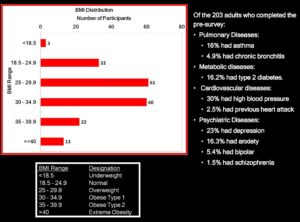Yes, it’s the season to eat your way through plates of Christmas cookies, and laugh out loud at the ugly Christmas sweaters. I personally think it’s just fine, even important, to set aside some of our dietary convictions and enjoy the festivities – with all the cookies and desserts they bring. I always make a quiet promise to myself to get back on track with the start of the New Year, even if it is getting harder to zero out those calories. But staying on a healthy diet is tough business when the money is tight, and even tougher if you suffer with a chronic illness like diabetes, high blood pressure, or depression. Alexander Senetar reminded me of that this year when, a few days ago, I received his preliminary findings on the overall health of our clients.

Armed with surveys, Alexander started asking questions last summer. He asked our clients about their health concerns and overall eating habits. Of the 203 adults at Loaves & Fishes who completed his survey,
• 16% had asthma
• 16.2% had type 2 diabetes (almost twice the state average of 8.5%)
• 30% had high blood pressure
• 23% had depression
• 76.8% were overweight or obese (note: height and weight was self reported)

Happily, Alexander agrees. In fact, his follow-up surveys indicate that even brief nutritional programs like these can result in significant improvements in eating habits. That combination of healthy encouragement and the availability of healthy choices is vital to those who are managing chronic illnesses.
Thanks, Alexander, for helping us to realize the value of a friendly one-on-one conversation, as well as the need for them. I am guessing that Alexander will one day be a stand-out member of our medical professional community. For the full version of Alex’s findings, click here.
Jane Macdonald, Associate Director of Community Health